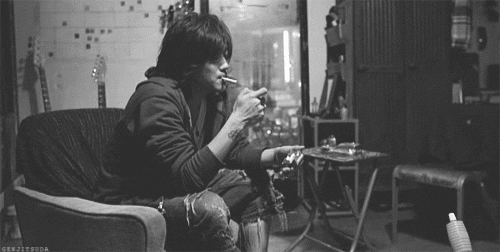 |
| gif by Genjitsuda |
Wednesday, June 25, 2014
Natsu
A Forrest Full of Charm: A Review of the First Ever Stage Adaptation of Forrest Gump
This is the first time that Forrest Gump was adapted for the
stage and I was very fortunate to secure a ticket to see it with a good seat. Last
June 8, 2014, I got to watch the matinee show of Forrest Gump at the Globe
Theater. The play was topbilled by famous Johnny’s idol and KAT-TUN member
Junnosuke Taguchi in the title role. This is Taguchi’s first ever starring role
in a stage play. He was joined by other famous actors such as Aki Maeda
(Jenny), Hitomi Takahashi (Forrest’s Mother) and Masahiro Takashima (played
seven characters including Lietutenant Dan). It was produced and written by G2
who is known for other high-quality stage productions in Tokyo.
 |
| Photo from QLAP Magazine |
Forrest Gump was originally a novel
written by Winston Groom in 1986 and was turned into a movie in 1994 with Tom
Hanks in the lead role. The story
revolves around the life of Forrest Gump who has a relatively low IQ as
compared to other people. Out of such condition blossomed the naivite of a
child and the purity of his heart that led him to great lengths – getting into
college and playing for the rugby team, meeting two American presidents,
joining the US Army, having a medal honor for saving his colleagues during the
Vietnam War, and becoming an astronaut just to name a few.
 |
| Photos from QLAP Magazine |
Highlights of the
Play
It has very smooth transitions and props-change. For a play that
has a very long and complicated timeline – starting from Forrest’s
childhood up to the time that he becomes an adult – transitions are very
difficult to pull off. The play also happens in different settings that require
proper establishment of environment and milieu. The life of Forrest is told
with a lot of historical events in the background starting from 1944 to 1986
such as the assassination of Kennedy, the Watergate Scandal, the Vietnam War,
and the hippie counterculture. The stage props are not grand but enough to
establish a particular setting. They’re simple, easy to move and very practical.
The best part I have to say is when they staged the part where Forrest and
Liuetant Dan are at sea, trying to catch some shrimps, when they encounter a
strong storm that almost sinks their ship. The construction of the scene is
quite simple. A blue cloth was put to cover the whole stage, and a small
elevated platform was set in the middle to serve as the boat. At the four
corners of the stage, there were people waving the blue cloth to create the
image of waves. The lighting on stage, hitting the blue cloth created a
beautiful imagery of ocean waves. It is not real but it gives you the right
feel.
The live music adds a certain vibe to the show. All the music
played within the whole show was actually played live. The musicians who played
the keyboard, the violin and other instruments, also played supporting roles in
the show. Sometimes they would play their instruments on the side, but on another
time, they would leap on stage and throw some lines. This is a clever way of
creating more people on stage. For a play like this, there are a lot of “extra
people” needed to play as friends, classmates, rallyists, soldiers or other
random people who do not have names but just need to be on stage to make a populated
scene look more credible. Using actors as instrumentalists and vice versa is a clever idea to maximize the potential of the cast.
 |
| Photo from QLAP Magazine |
Another strong point is Taguchi’s
live playing of the harmonica. I was surprised at how well he could actually do it with
just about four months of learning it. I am no music expert, but when I listen
to it, sometimes, I feel like, some notes are wavering a little, but not so bad
as to distract you from the beautiful music. For me, it is believable. He plays the harmonica like someone who does it as a hobby.
Though I like the live music so
much, sometimes, I feel like it is not very consistent. There were some scenes that make give me the pseudo-musical feel, but then this feel was not sustained for the whole show. There was a scene showing Taguchi and his
classmates singing and dancing in class, and a few ones with Jenny
singing on stage with the new band that she had just joined. There is an
incorporation of live music played on stage and off stage, which I like, but I
would have preferred more on stage. I understand though that this play was
written not as a musical so I can actually forgo this minor point. More so, the beautiful music of the violin and the harmonica overpowered my disappointment.
The imagery of the opening and the last
scene created a perfect circle. I like how the play started and ended, basically because they happened in the same setting. The play opened with a
scene with Forrest and his famous bench and it ended with him in the same
place, but with Jenny and their little son. For me, the imagery created a full
circle in the life of Forrest, from being a kid to growing up, losing Jenny and
finding her again, from little Forrest to having Forrest Jr.
Best Scenes
As I have
mentioned earlier, the part when Forrest and Liutenant Dan are at sea is very
good and heartwarming for me, not only because the scene is so beautiful with
the blue cloth and the lighting on stage, but also because it is the part where
Liutenant Dan finally realizes that he should be thankful to Forrest for saving
his life in Vietnam.It is not too sentimental, not too dramatic, it has just the right emotions for me. But another good part is the ending. At the end of the
play, the whole theater dimmed and small lights lighted up on stage like stars in
the sky. Forrest delivered again the lines that he first said in the opening scene. The scene is so
peaceful, seeing it as the last image of the whole play creates a light,
heartwarming feel as you exit the theater.
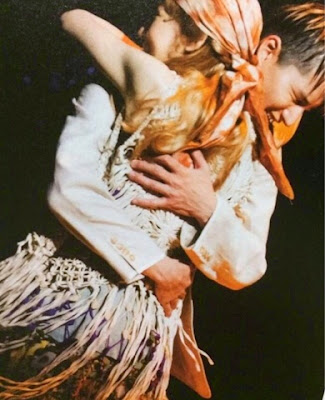 |
| Photo from QLAP Magazine |
Junnosuke Taguchi as
Forrest Gump
Taguchi is a very charming
Forrest Gump – too charming, actually. This is a double standard though, it can either work for or against the production depending on what the audience is looking for. I am sure that there are other
more experienced actors who can play Forrest better than Taguchi, but he put some of his own flavor in the character. His acting is sometimes theatrical, yet not
contrived; very light and easy on the eyes; very smooth and amusing to see.
Taguchi owned the role of Forrest. This is not the Forrest that I am expecting
to see on stage when I entered the theater. I am expecting a different kind of
Forrest, probably because I already have an image of another Forrest on my
mind. But the thing is, Taguchi created his own version of Forrest Gump – the
iriguchi-deguchi-taguchi-Gump if I may say. It is the overwhelmingly charming,
lighthearted, beautiful Forrest. He may not be the best actor who can play the
role, but he made a way to claim a particular version of Forrest as his own –
enough to make me respect him more as an actor.
Note: Usually, when Taguchi introduces himself he says, "Iriguchi, Deguchi, Taguchi desu!" It literally means "Entrance, Exit, I'm Taguchi!" (^_^)
Note: Usually, when Taguchi introduces himself he says, "Iriguchi, Deguchi, Taguchi desu!" It literally means "Entrance, Exit, I'm Taguchi!" (^_^)
Saturday, June 14, 2014
Niku Shokudou
Niku Shokudou is a small restaurant near the Takadanobaba Station
that specializes in sizzling hamburger steaks. A set meal consists of
rice, salad and a sizzling hamburger steak costs around Y800.
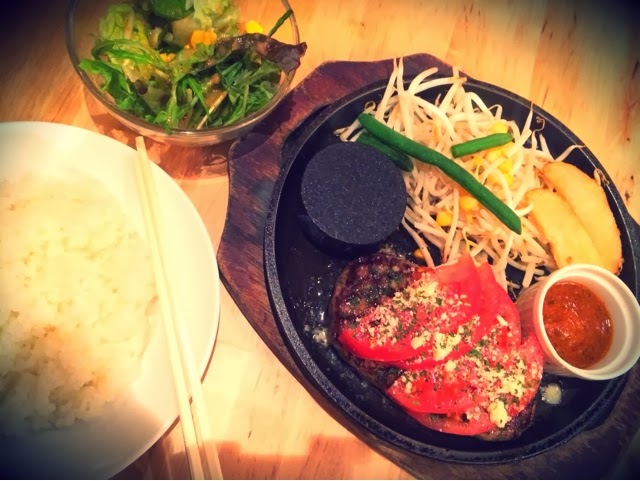 What amazes me is how you cook the burger patty. There's a small round
black metal on your plate where you can put a piece of the burger and
wait until it cooks. Brilliant isn't it? Most of us are having trouble
getting the correct texture of the meat we order: some like rare,
medium-rare or well done. Having this small tool right on our plates
solves the problem right away. We won't have the right to complain if we
don't like the texture of the meat because we cooked it ourselves. ;)
What amazes me is how you cook the burger patty. There's a small round
black metal on your plate where you can put a piece of the burger and
wait until it cooks. Brilliant isn't it? Most of us are having trouble
getting the correct texture of the meat we order: some like rare,
medium-rare or well done. Having this small tool right on our plates
solves the problem right away. We won't have the right to complain if we
don't like the texture of the meat because we cooked it ourselves. ;) 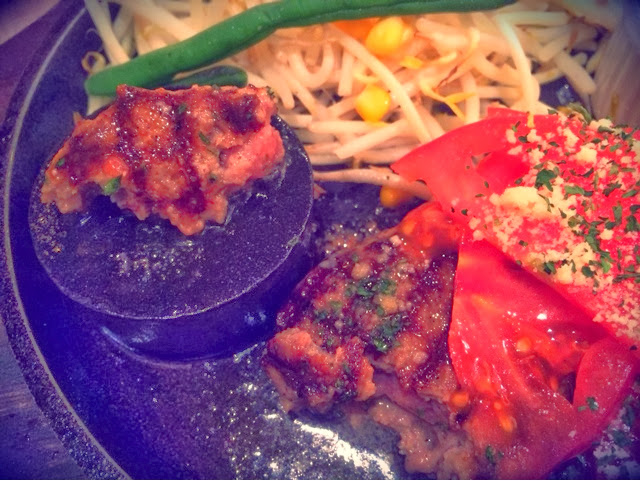
To get there, take the JR Yamanote Line and get off at
Takadanobaba Station. Go to the Waseda Exit and find Becks Coffee (right
beside the JR ticket office). From Becks Coffee, cross the street and
walk straight ahead towards a long line of restaurants and cafes. Walk
for a minute or two and you'll find the restaurant on your left side. Be
careful though because the entrance to the restaurant easy to miss
because it's so small and hardly noticeable. I posted the photo of the
entrance above as your guide. The restaurant is on the basement of this
restaurant. It's quite small with only a few tables and chairs.
 |
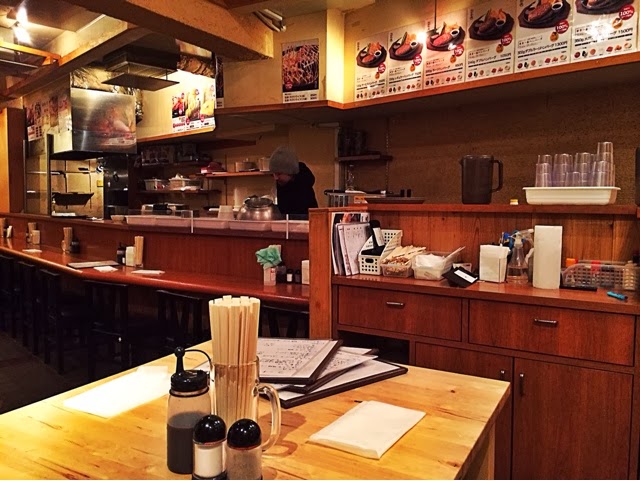 |
For the hungry wolves though, this is not the place to go because preparing the order and cooking it might take a long time. But if you have time to spare for a good talk with a friend or a few laughs with the stranger on the next table, waiting will not be so bad.
Wednesday, June 4, 2014
Art Overdose: Art Fair Tokyo 2014
***originally published in the May Issue of Pinoy Gazette
Also published on Pinoy Gazette`s official blog: pinoygazetteofficial.blogspot.jp
.jpg) |
| Kuha ni Munetoshi Iwashita |
Noong nakaraang buwan ay ginanap
ang pinakamalaking art event sa Tokyo na pinakaaabangan hindi lamang ng art
collectors at professional artists, kundi pati na rin ng mga nag-aasam gumuhit
at mga gusto lamang makakita at mamangha sa iba't ibang klase ng malikhaing
gawa.
Ang Art Fair Tokyo 2014 na
ginanap sa Tokyo International Forum ay nilahukan ng mahigit-kumulang 180
galleries, organizations at sponsors mula sa 28 siyudad sa Japan at iba pang
bahagi ng mundo. Kabilang ang Embahada ng Pilipinas sa mga sumuporta sa event
na ito. Sa nakaraang walong taon ng Art Fair, ito ang unang pagkakataon na
mayroong lumahok na gallery mula sa Pilipinas.
Dumalo ang ilang mahahalagang tao
tulad ni Unang Ginang Akie Abe, maybahay ni Prime Minister Shinzo Abe, sa
Kagami-biraki sake cask ceremony, na opisyal na nagbukas sa Art Fair. Sa loob
ng apat na magkakasunod na araw ay itinampok sa Art Fair ang iba't ibang klase
ng gawa, nasa linya man ng fine arts o applied arts kabilang dito ang Nihongo o
Japanese-style painting, Yoga o Japanese oil painting, contemporary art, media
art, pop art, mga litrato, at ilang antique at handicraft. Nagkaroon din ng mga
panayam tungkol sa woodblock prints at media art. Nagsagawa rin ng guided tours
para sa ilang mga bisita.
Bukod sa indibidwal na mga
gallery na nagpakita ng gawa ng kanilang mga sariling artists, ilan sa mga
highlights ng Art Fair ay ang sumusunod:
Discovering Asia. Sa section na ito
nakibahagi ang ilang mga gallery mula sa Korea, Taiwan, Hong Kong, Indonesia at
Pilipinas upang ipakita ang mga gawa mula sa kanilang mga bansa kabilang dito
ang 1335 Mabini na mula sa Pilipinas. Sila ang kauna-unahang Filipino gallery
na nakilahok sa Art Fair.
Artistic Practice. Ang section na ito ay may
temang “Modernity, Created by Japan” na siyang kinabibilangan ng mga modern
painting na nagpapakita ng pagbabago sa tema at technique sa pagguhit ng isang
bagong henerasyon ng Japanese artists. Kabilang ang ilan sa mga gawa nina Kaoru
Yamaguchi, Soutaro Yasui, at Ryuzaburo Umezawa sa ipinakita sa Art Fair.
Tokyo Unlimited. Sa bahaging ito ipinakita ang
iba't ibang applied art tulad ng handicrafts, pottery, ceramics at alahas. Ilan
sa mga gallery na nakibahagi ay ang Toyama Glass Studio, gallery deux poissons,
O-Jewel at Kanazawa Utatsuyama Kogei Kubo.
Art, Media and I, Tokyo. Kapansin-pansin kamakailan ang
pagiging popular ng media art kung saan gumagamit ang mga artists ng kanilang
sariling sistema, device at medium ng paggawa ng painting na iba kaysa sa
pangkaraniwang ginagamit. Ang section na ito ay may layuning ipakita kung paano
ang mga media art na gawang Hapon ay higit na maipapakilala sa global art
market. Tampok sa exhibit na ito ang mga gawa ng ShimuraBros at nina Yuko
Mohri, at Lyota Yagi.
Total Recall - Works of
Mitsutoshi Hanaga (1959-1999).
Itinatampok sa bahaging ito ang mga larawang kinuhanan ni Mitsutoshi Hanaga
mula 1959-1999 na nagtatampok ng mga aktibidades ng mga avante-gard Japanese
artists tulad ng grupong Hi-Red Center at nina Tetsumi Kudo, Akaji Maro at
kanji Ito.
Pap-Aki Cafe Project. Gamit sa munting cafe na
ito ang mga upuan at lamesa na gawa sa makakapal na karton na ginuhitan ng
matitingkad na larawan ni Aki Kondo.
Dinaluhan ang Art Fair ng halos 50,000 bisita mula sa iba't ibang panig ng Japan at ng mundo. Umabot rin ng halos isang bilyong yen ang halaga ng mga art pieces na naibenta sa loob ng apat na araw ng Art Fair. Patunay lamang ang ika-siyam na taon ng Art Fair Tokyo sa patuloy na pagiging globally competitive ng bansa at higit na nagkakaroon ng mataas na value ang mga malikhaing gawa mula sa Asya.
Subscribe to:
Posts (Atom)
Translate
About the Author

- imcapitalbarbie
- Tokyo, Japan
- I am living my dreams everyday in my overlapping world of fantasy and reality; in love with tokyo and will forever be in love with the tokyo tower, discovered my new love for the sun, the sand and the waves; love pedestrian lanes and enjoy crossing them; treasure old photographs and memories; want to learn how to play the violin; always challenge myself to try new things; dream of publishing a book; adore taking photos of clouds; want to work for the greater good of humanity; hope to inspire others with my simple stories; recede in my own world when I listen to jazz; scared to ride a ferris wheel but in love with the idea of riding it; daydream as often as I breathe; live a life of traveling, dreaming, believing. Love to live, Live to love.
Popular Posts
-
 China House Keikarou: Aiba Mama's Restaurant
China House Keikarou: Aiba Mama's Restaurant
-
 Sand Dune Bashing at Sand Boarding sa Ilocos Norte
Sand Dune Bashing at Sand Boarding sa Ilocos Norte
-
 A Forrest Full of Charm: A Review of the First Ever Stage Adaptation of Forrest Gump
A Forrest Full of Charm: A Review of the First Ever Stage Adaptation of Forrest Gump
-
 In the Footsteps of Haruki Murakami: The Old Blind Cat
In the Footsteps of Haruki Murakami: The Old Blind Cat
-
 Mga Kwentong Katatakutan sa Japan
Mga Kwentong Katatakutan sa Japan
-
 Jazz Bar in Jimbocho: Big Boy
Jazz Bar in Jimbocho: Big Boy
-
 Living in Haruki Murakami's World: Walking Tour in Shinjuku
Living in Haruki Murakami's World: Walking Tour in Shinjuku
-
 Blood Ceilings at Genkoan Temple
Blood Ceilings at Genkoan Temple
-
 Tochigi in Winter: Kinugawa Onsen
Tochigi in Winter: Kinugawa Onsen
-
 Castles in Japan: Sunomata Ichiya Castle
Castles in Japan: Sunomata Ichiya Castle
Categories
travels
(54)
travelsjapan
(48)
everydaytokyo
(32)
randomthoughts
(24)
idiosyncracies
(21)
food
(17)
restaurants
(16)
japantravels
(11)
Cafes
(10)
japan
(10)
japan travels
(9)
travelstokyo
(9)
tokyotravels
(8)
Japanese Government Scholarship
(6)
asia travels
(6)
scholarships abroad
(6)
study in Japan
(6)
saitama
(5)
Monbukagakusho
(4)
Monbusho
(4)
how to get a scholarship
(4)
how to study in Japan
(4)
study abroad
(4)
Government of Japan
(3)
kanagawa
(3)
Arashi
(2)
Japan Winter
(2)
Yomiuri Giants
(2)
tokyo travels
(2)
waseda university
(2)
monbukagakusho study ajavascript:void(0);broad
(1)
tokyo tower
(1)


